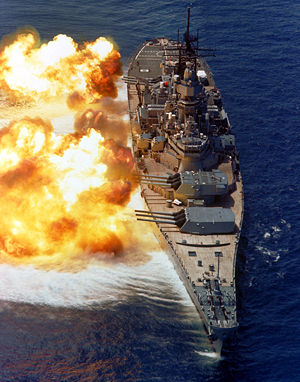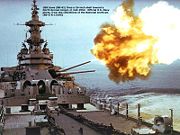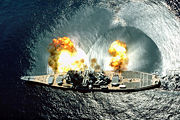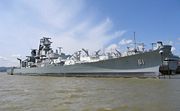The USS Iowa had along history to it. I was thinking about my dad
just before it started to hide another cache. That when I started
to remember all the stories he told me about when he served on the
Aircraft carrier. The one’s that sticks out most about the
battleships. Firing all the guns one after another, He told me it
was breath taking. Knowing how much power it was firing at one
time. During some of the island campaigns. He watched the guns
being fired. But I could be there all day typing stories that he
told me, so I got the history of USS IOWA.
THE CACHE IS NOT AT THE POSTED CORRDINATES
USS Iowa (BB-61), the lead ship of the Iowa class battleship, was
the fourth United States Navy ship, and the second commissioned
one, to be named in honor of the state of Iowa. Iowa's keel was
laid down on 27 June 1940 at the New York Navy Yard. Nicknamed "The
Big Stick," the battleship was launched on 27 August 1942 sponsored
by Ilo Wallace (wife of Vice President Henry Wallace), and
commissioned on 22 February 1943 with Capt. John L. McCrea in
command.
 On 24 February 1943, Iowa put to sea for shakedown
in Chesapeake Bay and along the Atlantic coast. She got underway on
27 August for Naval Station Argentia, Newfoundland, to neutralize
the threat of German battleship Tirpitz, which was reportedly
operating in Norwegian waters.
On 24 February 1943, Iowa put to sea for shakedown
in Chesapeake Bay and along the Atlantic coast. She got underway on
27 August for Naval Station Argentia, Newfoundland, to neutralize
the threat of German battleship Tirpitz, which was reportedly
operating in Norwegian waters.
In the fall, Iowa carried President Franklin D. Roosevelt to
Casablanca, French Morocco, on the first leg of the journey to the
Tehran Conference in November. After the conference, the ship
returned the president to the United States.
As flagship of Battleship Division 7, Iowa departed the United
States 2 January 1944 for the Pacific Theater and the ship's combat
debut in the campaign for the Marshall Islands. From 29 January to
3 February, she supported carrier air strikes made by Rear Adm.
Frederick C. Sherman's task group against Kwajalein and Eniwetok
Atolls. Iowa's next assignment was to support air strikes against
the Japanese naval base at Truk, Caroline Islands. In company with
other ships, Iowa was detached from the support group 16 February
1944 to conduct an anti-shipping sweep around Truk to destroy enemy
naval vessels escaping to the north. On 21 February, she was
underway with the Fast Carrier Task Force (TF 58 or TF 38,
depending on whether it was part of 5th Fleet or 3rd Fleet) while
it conducted the first strikes against Saipan, Tinian, Rota, and
Guam in the Mariana
Islands. On 18 March, Iowa, flying the flag of Vice Adm. Willis A.
Lee, commander of Battleships, Pacific, joined in the bombardment
of Mili Atoll in the Marshall Islands. Although struck by two
Japanese 4.7 inch projectiles during the action, Iowa suffered
negligible damage. She rejoined Task Force 58 on 30 March and
supported air strikes against the Palau Islands and Woleai of the
Carolines; these continued for several days.
From 22 April to 28 April 1944, Iowa supported air raids on
Hollandia (currently known as Jayapura), Aitape, and Wakde Islands
to support Army forces on Aitape, Tanahmerah Bay, and Humboldt Bay
in New Guinea. The battleship then joined the task force's second
strike on Truk, 29 April and 30 April, and bombarded Japanese
facilities on Ponape in the Carolines on 1 May.
In the opening phases of the Marianas campaign, Iowa protected the
aircraft carriers during air strikes on the islands of Saipan,
Tinian, Guam, Rota and Pagan on 12 June. Iowa was then detached to
bombard enemy installations on Saipan and Tinian on 13 June and 14
June. On 19 June, in an engagement known as the Battle of the
Philippine Sea, Iowa, as part of the battle line of TF 58, helped
repel four massive air raids launched by the Japanese Middle Fleet.
This resulted in the almost complete destruction of Japanese
carrier-based aircraft. Iowa then joined in the pursuit of the
fleeing enemy fleet, shooting down one torpedo plane and assisting
in splashing another.
Throughout July, Iowa remained off the Marianas, supporting air
strikes on the Palaus and landings on Guam. After a month's rest,
Iowa sortied from Eniwetok as part of the Third Fleet, and helped
support the landings on Peleliu on 17 September. The battleship
then protected the carriers during air strikes against the Central
Philippines to neutralize enemy air power for the long-awaited
invasion of the Philippines. On 10 October, Iowa arrived off
Okinawa for a series of air strikes on the Ryukyu Islands and
Formosa. The battleship then supported air strikes against Luzon on
18 October and continued this vital duty during General Douglas
MacArthur's landing on Leyte on 20 October.
In a last-ditch attempt to halt the U.S. campaign to recapture the
Philippines, the Japanese Navy struck back with a three-pronged
attack aimed at the destruction of American amphibious forces in
Leyte Gulf. Iowa accompanied TF 38 during attacks against the
Japanese Central Force as it steamed through the Sibuyan Sea toward
San Bernardino Strait. The reported results of these attacks and
the apparent retreat of the Japanese Central Force led Adm. William
"Bull" Halsey to believe that this force had been ruined as an
effective fighting group. Iowa, with TF 38, steamed after the
Japanese Northern Force off Cape Engaño, Luzon. On 25 October 1944,
when the ships of the Northern Force were almost within range of
Iowa's guns, word arrived that the Japanese Central Force was
attacking a group of American escort carriers off Samar. This
threat to the American beachheads forced the battleship to reverse
course and steam to support the vulnerable "baby carriers".
However, the valiant fight put up by the escort carriers and their
screen in the Battle off Samar had already caused the Japanese to
retire and Iowa was denied a surface action. Following the Battle
of Leyte Gulf, Iowa remained in the waters off the Philippines
screening carriers during strikes against Luzon and Formosa. It
sailed for the West Coast late in December 1944.
Iowa arrived in San Francisco, California, on 15 January 1945, for
overhaul. The battleship sailed 19 March for Okinawa, arriving 15
April. Commencing 24 April, Iowa supported carrier operations that
assured American troops vital air superiority during their struggle
for that bitterly contested island. The battleship then supported
air strikes off southern Kyushu from 25 May to 13 June. Iowa
participated in strikes on the Japanese homeland 14 July and 15
July and bombarded Muroran, Hokkaido, destroying steel mills and
other targets. The city of Hitachi on Honshu was given the same
treatment on the night of 17 July to 18 July. Iowa continued to
support fast carrier strikes until the cessation of hostilities on
15 August.
Iowa entered Tokyo Bay with the occupation forces on 29 August.
After serving as Adm. Halsey's flagship for the surrender ceremony
on 2 September, Iowa departed Tokyo Bay 20 September for the United
States.
Arriving Seattle, Washington on 15 October, Iowa returned to
Japanese waters in January 1946 and became flagship of the Fifth
Fleet. The battleship continued this role until it sailed for the
United States on 25 March 1946. From that time on, until September
1948, Iowa operated from West Coast ports, on Naval Reserve and at
sea training and drills and maneuvers with the fleet. She was
decommissioned 24 March 1949.
 The Korean War
The Korean War
USS Iowa firing a 16-inch shell towards a North Korean target in
1952. The USS Iowa firing a 16-inch shell towards a North Korean
target in 1952As America's involvement in the Korean War led to an
expansion of the active fleet, Iowa was recommissioned on 25 August
1951 with Capt. William R. Smedberg III in command. She operated
off the West Coast until March 1952, when it sailed for the Far
East. On 1 April 1952, Iowa became the flagship of Vice Adm. Robert
P. Briscoe, commander of the Seventh Fleet, and departed Yokosuka,
Japan, to support United Nations forces in Korea. The conflict had
entered its stalemate period by this date. From 8 April to 16
October 1952, Iowa was involved in combat operations off the east
coast of Korea: the primary mission was to aid ground troops by
bombarding enemy targets at Songjin, Hungnam, and Kojo, North
Korea. During this time, Adm. Briscoe was relieved as commander of
the Seventh Fleet. Vice Adm. Joseph J. Clark, the new commander,
continued to use Iowa as his flagship until 17 October 1952. Iowa
departed Yokosuka, Japan, on 19 October 1952 for overhaul at
Norfolk, Virginia and training operations in the Caribbean Sea. The
Korean War came to an end when a cease-fire was reached on July 27,
1953.
1953 to 1958
The USS Iowa firing during target exercises near Vieques, Puerto
RicoIowa embarked midshipmen for at sea training to northern
Europe, July 1953, and immediately after took part in Operation
"Mariner," a major NATO exercise, serving as flagship of Vice Adm.
Edmund T. Wooldridge, commanding the Second Fleet. Upon completion
of this exercise, until the fall of 1954, Iowa operated in the
Virginia Capes area. In September 1954, Iowa became the flagship of
Rear Adm. R. E. Libby, commander of the Battleship Cruiser Force,
Atlantic Fleet. From January to April 1955, Iowa made an extended
cruise to the Mediterranean Sea as the first battleship regularly
assigned to the commander of the Sixth Fleet. Iowa departed on a
midshipman training cruise 1 June 1955 and upon return, entered
Norfolk, Va., for a four-month overhaul. Following refit, Iowa
continued intermittent training cruises and operational exercises,
until 4 January 1957 when the battleship departed Norfolk for duty
with the Sixth Fleet in the Mediterranean. Upon completion of this
deployment, Iowa embarked midshipmen for a South American training
cruise and joined in the International Naval Review off Hampton
Roads, Virginia, on 13 June 1957. On 3 September 1957, Iowa sailed
for Scotland for NATO Operation "Strikeback". Iowa returned to
Norfolk on 28 September 1957 and departed Hampton Roads for the
Philadelphia Naval Shipyard on 22 October 1957. She was
decommissioned once again, 24 February 1958, and entered the
Atlantic Reserve Fleet at Philadelphia. 
1985-1988
After a quarter-century in mothballs, Iowa was modernized,
primarily at Avondale Shipyards near New Orleans, Louisiana as part
of President Ronald Reagan's "600-ship Navy" plan, and
recommissioned 28 April 1984. Sister ships New Jersey, Missouri,
and Wisconsin were similarly modernized and reactivated at this
time. Iowa went to European waters in 1985, 1986 and 1987 through
1988, with the latter cruise continuing into the Indian Ocean and
Arabian Sea. During that cruise, Iowa participated in Operation
Earnest Will, escorting Kuwaiti gas and oil tankers "reflagged" as
U.S. merchant ships from the Persian Gulf through the Straits of
Hormuz. During the 1980s, the Navy proposed to create a homeport at
Stapleton, Staten Island in New York City, which was to be the base
for Iowa and several other ships, but the project was canceled
before its completion.
1989 Turret Explosion
USS Iowa turret explosion Heavy smoke pours from Turret #2
following an explosion 19 April 1989On 19 April 1989, an explosion
ripped through Iowa's number two 16-inch (406 mm) gun turret,
killing 47 crewmen. A sailor quickly flooded the #2 powder
magazines, annular space and powder flats, likely preventing
catastrophic damage to the ship. At first, the NCIS investigators
theorized that one of the dead crewman, Clayton Hartwig, had
detonated an explosive device in a suicide attempt after the end of
an alleged homosexual affair with another sailor. This theory was
later abandoned and Hartwig cleared. The cause of the explosion,
though never determined with certainty, is generally believed to
have been static electricity igniting loose powder.
Testing at the Naval Surface Warfare Center in Dahlgren, Virginia
of powder in the same lot was able to reproduce spontaneous
combustion of the powder, which had been originally milled in the
1930s and stored during a 1988 dry-docking of the Iowa in a barge
at the Naval Weapons Station in Yorktown, Virginia. Gunpowder gives
off ether gas as it degrades; the ether is highly flammable, and
can be ignited by a spark. Iowa's CO, Capt. Fred Moosally, was
severely criticized for his handling of the matter, and the Navy
changed the powder-handling procedures. Iowa deployed to Europe and
the Mediterranean Sea in mid-year, with Turret Two
unrepaired.
1990-2001
 Iowa was decommissioned in Norfolk for the last
time, 26 October 1990. In 1999 the Iowa replaced the New Jersey in
the Naval Register as part of the The National Defense
Authorization Act of 1999. The New Jersey had initially been
selected to fill the requirement of the 1996 Defense Authorization
Act to reinstate two battleships to the Register as the New Jersey
was deemed easier to return to service condition than the
blast-damaged Iowa. As part of the National Defense Reserve Fleet,
Iowa, was berthed next to the aircraft carrier USS Forrestal at the
Naval Education and Training Center in Newport, R.I., from 24
September 1998 to 8 March 2001, when the ship began a journey,
under tow to it’s new home.
Iowa was decommissioned in Norfolk for the last
time, 26 October 1990. In 1999 the Iowa replaced the New Jersey in
the Naval Register as part of the The National Defense
Authorization Act of 1999. The New Jersey had initially been
selected to fill the requirement of the 1996 Defense Authorization
Act to reinstate two battleships to the Register as the New Jersey
was deemed easier to return to service condition than the
blast-damaged Iowa. As part of the National Defense Reserve Fleet,
Iowa, was berthed next to the aircraft carrier USS Forrestal at the
Naval Education and Training Center in Newport, R.I., from 24
September 1998 to 8 March 2001, when the ship began a journey,
under tow to it’s new home.
Now you start looking where the cache is hidden.
42 A.3B
92 C.D
A) What is the top speed “Knots” ?
B) What is the draft ? Round to the nearest whole number.
C) What day was Uss Iowa decommissioned ?
D) Now Find where the Uss Iowa located at. Now take the first part
of the Longitude"Degree" + 48 "Use the ship itself."
You can check your answers for this puzzle on
Geochecker.com.